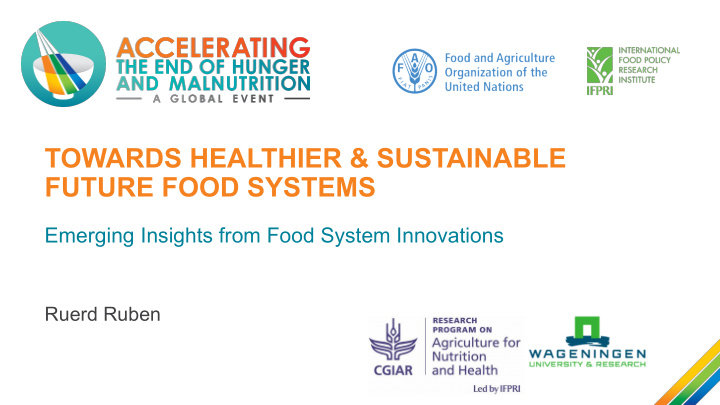



TOWARDS HEALTHIER & SUSTAINABLE FUTURE FOOD SYSTEMS Emerging Insights from Food System Innovations Ruerd Ruben
Food System Approach Linking production to consumption/nutrition Dovetailing technical with behavioural change Focus on critical drivers of change Involving public, private & civic actors Matching local to globlal outcomes From problem-solving to systems solutions
Drivers of food system change Multiple Levels Multiple Agents Food storage, Agricultural Country Food supply systems Government transport production and trade Region Producers Food environment Village Consumer Traders Neighbourhood Retailers Diet quality Family Households Food retail & Food provisioning transformation Intra-household Persons
Di Diverse M Motives f for F r Food ood Choices Eating Motivations • Liking • Habits • Needs • Physical well-being • Convenience • Pleasure • Tradition • Nature concerns • Sociability • Price • Physical appeal • Weight control • Affect regulation • External demands • Social image
Main trends & challenges Connectivity Resource intensity Supermarket expansion & out- Rapid urbanization & growth of of-home consumption megacities Food prices & market volatility Climate change and yield gaps ICT revolution in agri-food Dietary changes & protein value chain transition
Changing Rural & Urban Diets Slowly reducing share of staples Strong increase intake of (ultra)processed food Moderate increase in fruit & vegetables Rising demand for animal-based food India: more calories, less proteins, more fats & sugar
Multiple Markets
Food purchase from multiple income sources Purchase of Food Income & market diversification may support dietary diversy Open market Street vendors Corner shop Supermarket Fastfood Out-of-home
Nutrition-sensitive & circular Value Chains • Packaging & storage for reducing loss and maintaining quality • Reducing lead time & extending shelf life • Efforts at the start of the value chain give returns at the end agency coordination required • Also promising for local vegetables varieties with high nutrient content
From institutional to home consumption • School meals , hospital & prison canteens, company restaurants • Support school enrollment and workplace attendance • Direct nutritional effects (social protection; rapid hospital recovery) • Spillovers to household behaviour
Personalized nutrition • Nutritional labelling (Organic, Sustainable, Fair, GMO) • ICT opportunities: internet shopping & home delivery (+ gender empowerment) • Tailoring food supply to individual demands and needs (vouchers; Veg-on-Wheels) • Individualized messages: Bar / QR codes in health apps , prompting healthy food
Pull & push policies • Nudging consumers towards healthier food choices • Retail environment influences ‘easiness’ of food choices • Moderating intake of candies and soft drinks (barriers) • Taxing sugar and fat content (or: provider-get subsidies)
Public – private partnerships Public Policies Private Contracts Price & non-price support for Long-term contractual delivery healthier food agreements Focus on availability, safety & Involvement of all supply chain easiness agents Community platforms for Mainstreaming sustainability & procurement of healthy foods fairness (living wage)
Outlook & Future Challenges 1. Tailoring food supply to consumer’s motives & social norms 2. Public role for shaping a conducive (urban) food environment 3. Business partnerships to uplift food standards 4. Citizen platforms to enhance neighbourhood participation 5. Experiments towards food systems co-innovation
Thanks for your attention 15
Recommend
More recommend